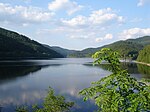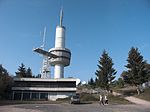Wieda (river)
Lower Saxony river stubsRivers of GermanyRivers of Lower SaxonyRivers of ThuringiaRivers of the Harz ... and 1 more
Thuringia river stubs

The Wieda is a river in the German states of Lower Saxony and Thuringia. The Wieda has its source above the village of Wieda, flows through the village of Walkenried, the hamlet of Wiedigshof and the village of Gudersleben before discharging in the Harz river Zorge near Woffleben, a district of Ellrich. Its channel regularly dries up in the summer months - it sinks into the karst soil and reappears in other places as springs. Its most important tributary is the Uffe.
Excerpt from the Wikipedia article Wieda (river) (License: CC BY-SA 3.0, Authors, Images).Wieda (river)
Alte Loch, Harz (Landkreis Göttingen)
Geographical coordinates (GPS) Address Nearby Places Show on map
Geographical coordinates (GPS)
| Latitude | Longitude |
|---|---|
| N 51.661944444444 ° | E 10.556611111111 ° |
Address
Alte Loch
Alte Loch
37445 Harz (Landkreis Göttingen)
Lower Saxony, Germany
Open on Google Maps







